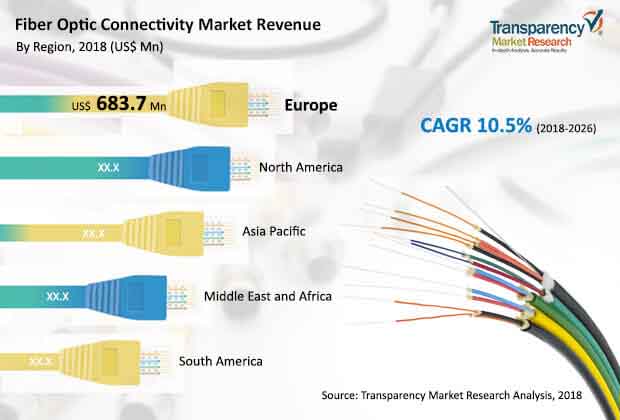
Fiber Optic Connectivity Market – Snapshot
Fiber optic connectivity is a communication exchange technology in which information from one place to another is transferred with the help of light through an optical fiber. Fiber optic connectivity offers high-speed data transmission. Fiber optic connectivity finds application in various industries such as telecommunication, energy & utilities, smart cities, power stations, as well as residential applications. These solutions make use of a number of fiber optical components. Majority of these components include optical cables, fiber optic cable assemblies, hybrid cables, optical couplers, patch cords and pigtails, optical connectors, enclosures/ fiber boxes, manufacturing and cleaning tools, optical transceivers, cabling systems (cable dividers, distributors, junctions), wavelength division multiplexers/de-multiplexers, and optical circulators. These components are widely used in FTTx applications and during deployment of fiber optic networks. These components also find use in applications such as fiber in the loop (FITL), interoffice, loop feeder, synchronous digital hierarchy (SDH) systems, hybrid fiber-coaxial cable (HFC), and synchronous optical network (SONET).
Increasing demand for energy-efficient networking solutions across industries is anticipated to drive the fiber optic connectivity market. Fiber optic networks use a single type optic and single fiberinwork group terminal (WGT). In addition, it uses small optical splitters, located at the enclosures in a building, usually at every floor. Therefore, optical network produces no heat, requires less power, and can even be mounted in electrical closets. These benefits along with its ability of fire load savings capability have made fiber optic networks an energy-efficient solution. Furthermore, fiber optic networks have low cost of ownership and high return on investment as compared to traditional cable networks. Low cost associated with fiber optic networks and components are leading to growing adoption of fiber optic connectivity across data centers. However, technical and operational issues such as attenuation, dispersion, data and signal losses associated with fiber optics are expected to restraint the market during the forecast period. Apart from this, flourishing growth of wireless networking systems across the world is anticipated to hamper the fiber optic connectivity market in long-term. Emerging fiber optic connectivity across countries such as China, Japan, India, Malaysia, and Singapore is expected to offer lucrative opportunities to the market as well as to the vendors.
Get Sample Copy of the Report to understand the structure of the complete report (Including Full TOC, Table & Figures): https://www.transparencymarketresearch.com/sample/sample.php?flag=B&rep_id=45906

The fiber optic connectivity market is segmented based on component, industry, and geography. In terms of component, the market can be classified into hardware, software, and services. Among the components, hardware is further categorized into fiber optic cables, fiber optic connectors, fiber optic cable assemblies, hybrid cables, cabling systems(cable dividers, distributors, junctions), enclosures/ fiber boxes, manufacturing and cleaning tools, wavelength division multiplexers, transceivers and switches. Services are classified into professional services and testing services. By industry, the fiber optic connectivity market is segmented into mining, oil & gas, wind power, electric substation, and smart cities (building automation and street furniture). Based on geography, the market is segmented into Asia Pacific, Europe, North America, South America, and Middle East & Africa. Among these regions, Europe covers a large share of the fiber optic connectivity market. This is primarily due to strong adoption and penetration of fiber optic components in industries such as oil & gas, wind power, electric substation, and smart cities. Asia Pacific and Middle East & Africa are anticipated to offer lucrative opportunities to the fiber optic connectivity market due to increasing investments and developments for digitization and automation of operations across the regions.
Request For Covid19 Impact Analysis Across Industries And Markets – https://www.transparencymarketresearch.com/sample/sample.php?flag=covid19&rep_id=45906
The global fiber optic connectivity market comprises a large number of international and domestic companies providing a wide range of fiber optic components. Some of the key vendors offering fiber optic components include Adtell Integration, Adtran, Inc., ADVA Optical Networking, Broadcom, Ciena Corporation, Cisco Systems, Inc., Corning Incorporated, Fiber Optic Services (FOS), Finisar Corporation, Fujitsu Optical Components Ltd., Hamamatsu Photonics K.K., Huawei Technologies Co., HUBER+SUHNER AG, Infinera Corporation, Lumentum Operations LLC, OptiLayer GmbH, Optiwave Systems, Inc., and ZTE Corporation.





